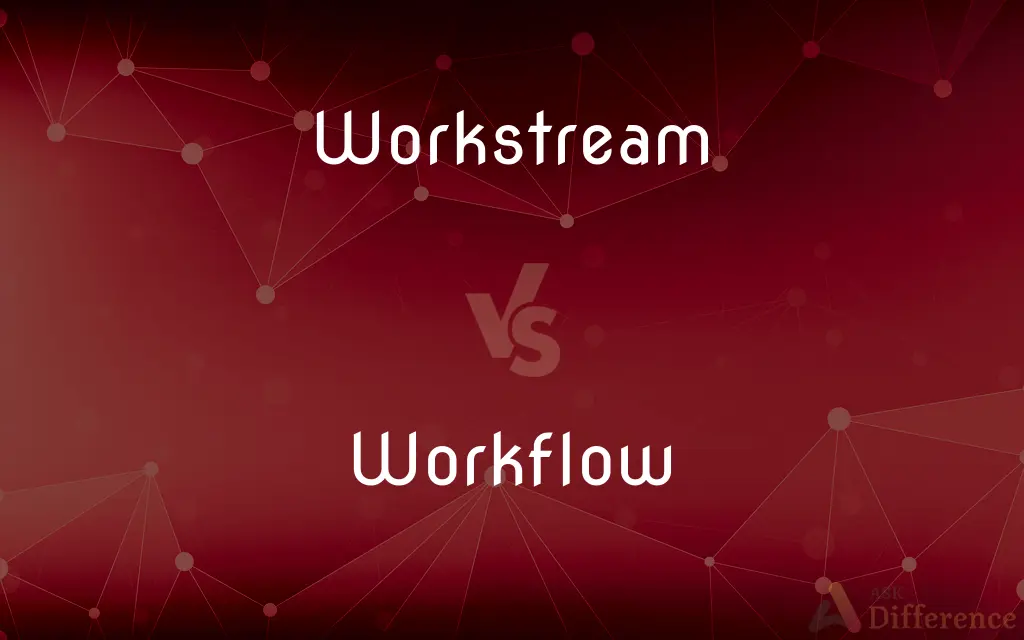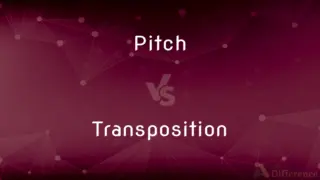Workstream vs. Workflow — What's the Difference?
By Tayyaba Rehman & Fiza Rafique — Updated on March 27, 2024
Workstream involves distinct subsets of tasks within a larger project, focused on a specific aspect, while workflow represents the sequence of processes through which a task moves from initiation to completion.

Difference Between Workstream and Workflow
Table of Contents
ADVERTISEMENT
Key Differences
Workstream refers to a set of activities or tasks that are part of a larger project or operational process, usually focused on a specific area or goal. These subsets of tasks are often managed independently within the broader project framework. Whereas workflow is the step-by-step process or sequence of activities required to complete a specific task or project, detailing how work moves from initiation to completion. It outlines the order of operations and the necessary actions at each step.
While workstreams can be independent or interdependent, functioning in parallel with other workstreams within a project, workflows are inherently sequential, emphasizing the progression of tasks from one stage to the next. A workstream may have its own internal workflow, illustrating how workflows can be components of workstreams.
Workstreams are often associated with specific teams or departments within an organization, focusing on their contributions to a larger project. On the other hand, workflows cut across various roles and departments, illustrating the cross-functional collaboration required to complete a task or process.
Moreover, managing workstreams typically involves overseeing the resources, timelines, and outputs specific to that stream, aligning them with the overall project or operational goals. Whereas managing workflows focuses on optimizing the process efficiency, reducing bottlenecks, and ensuring smooth transitions between tasks.
Workstreams are more about the "what" and "who" aspects of project management what needs to be done and who is responsible for it. Workflows, however, delve into the "how" and "when," detailing how each task will be executed and in what sequence to ensure efficient completion.
ADVERTISEMENT
Comparison Chart
Definition
A set of related tasks within a larger project, focusing on a specific goal.
A sequence of steps or processes through which a task moves from start to finish.
Focus
On specific project areas or goals.
On the sequence and efficiency of task execution.
Structure
Can be independent or interdependent with other workstreams.
Inherently sequential, detailing the order of task execution.
Associated With
Specific teams or departments.
Cross-functional roles and processes.
Management Focus
Resources, timelines, and outputs of specific areas.
Process efficiency, reducing bottlenecks, ensuring smooth task transitions.
Role in Projects
Broad subsets of a project with specific goals.
The detailed process flow within or across workstreams.
Emphasizes
"What" needs to be done and "who" is responsible.
"How" tasks are executed and in what sequence.
Compare with Definitions
Workstream
An operational segment of a business focusing on a particular set of activities.
Customer support is a crucial workstream in the service industry.
Workflow
The sequence of processes or steps required to complete a task or project.
The document approval workflow includes review, editing, and final approval steps.
Workstream
A subset of related tasks within a larger project, aimed at a specific goal.
The development workstream focuses on creating the software product.
Workflow
A set of rules or criteria defining the transition of tasks between different stages.
Our project management tool automates the workflow based on task priorities.
Workstream
A sequence of tasks or activities assigned to a specific team or department within a project.
The marketing workstream is responsible for campaign strategy and execution.
Workflow
A detailed outline of how tasks move from initiation to completion within a system.
The software development workflow starts with planning, followed by coding, testing, and deployment.
Workstream
Independent or interconnected series of tasks within a project, each with its own objectives.
Product design and manufacturing are separate but interdependent workstreams.
Workflow
The process flow involving multiple roles or departments in completing a task.
The order fulfillment workflow involves sales, warehouse, and shipping departments.
Workstream
A strategic area of focus within a project, requiring specialized resources and management.
The sustainability workstream aims to ensure environmental compliance across all operations.
Workflow
A diagram or model representing the sequence and decision points in a process.
The workflow diagram helps visualize the process steps and decision points.
Workstream
The organised output of several distinct, and often unrelated, work groups.
Workflow
A workflow consists of an orchestrated and repeatable pattern of activity, enabled by the systematic organization of resources into processes that transform materials, provide services, or process information. It can be depicted as a sequence of operations, the work of a person or group, the work of an organization of staff, or one or more simple or complex mechanisms.
Workflow
The flow or progress of work done by a company, industry, department, or person.
Workflow
The rate at which such flow or progress takes place.
Workflow
The rate at which a flow of work takes place
Workflow
(business) A process or procedure by which tasks are completed. It may be defined by a flowchart with actors, actions, results, decisions, and action paths.
Workflow
Progress (or rate of progress) in work being done
Common Curiosities
Can a project have multiple workstreams and workflows?
Yes, large projects often consist of multiple workstreams, each with its own internal workflows detailing task sequences.
Why is managing workstreams important?
Managing workstreams is crucial for aligning specific project areas or goals with the overall project objectives, ensuring resources and efforts are optimally distributed.
What role does technology play in managing workstreams and workflows?
Technology plays a crucial role in managing workstreams and workflows by providing tools for planning, tracking, and optimizing tasks and processes.
How can workflows be optimized?
Workflows can be optimized by analyzing process efficiency, identifying bottlenecks, and implementing tools or methods to streamline task transitions.
How do changes in a workstream affect workflows?
Changes in a workstream can lead to adjustments in workflows, as tasks or priorities within the workstream shift, necessitating updates to the sequence or execution of processes.
What is a workflow?
A workflow is the sequence of steps or processes through which a task or project moves from initiation to completion.
What are the benefits of a well-defined workflow?
A well-defined workflow improves process efficiency, reduces bottlenecks, and ensures tasks are completed in a timely and orderly manner.
What is a workstream?
A workstream is a subset of related tasks within a larger project or operational process, focusing on a specific goal or area.
How do workstreams and workflows interact?
Workstreams can contain multiple workflows, representing the specific sequences of tasks required within those broader subsets of a project.
How do workstreams contribute to project success?
Workstreams contribute to project success by ensuring focused management and execution of specific project areas or goals, facilitating specialized contributions towards the overall objectives.
What challenges might arise in managing multiple workflows?
Managing multiple workflows can present challenges in coordination, process integration, and maintaining efficiency across all tasks and stages.
Can workflows cross workstream boundaries?
Yes, workflows can cross workstream boundaries, especially in projects requiring cross-functional collaboration.
Is it necessary for every project to define its workstreams and workflows?
While not every project may formally define its workstreams and workflows, doing so can greatly enhance project management and execution efficiency.
Can the principles of workstreams and workflows apply to any industry?
Yes, the principles of workstreams and workflows are applicable across industries, as they are foundational concepts in project management and operational efficiency.
Share Your Discovery

Previous Comparison
Pitch vs. Transposition
Next Comparison
Logos vs. MythosAuthor Spotlight
Written by
Tayyaba RehmanTayyaba Rehman is a distinguished writer, currently serving as a primary contributor to askdifference.com. As a researcher in semantics and etymology, Tayyaba's passion for the complexity of languages and their distinctions has found a perfect home on the platform. Tayyaba delves into the intricacies of language, distinguishing between commonly confused words and phrases, thereby providing clarity for readers worldwide.
Co-written by
Fiza RafiqueFiza Rafique is a skilled content writer at AskDifference.com, where she meticulously refines and enhances written pieces. Drawing from her vast editorial expertise, Fiza ensures clarity, accuracy, and precision in every article. Passionate about language, she continually seeks to elevate the quality of content for readers worldwide.
















































